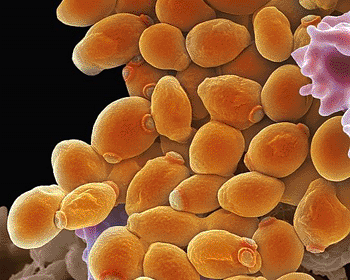Molecular Platform Evaluated for Yeast Infected Blood
By LabMedica International staff writers
Posted on 12 Mar 2012
A polymerase chain reaction (PCR) protocol has been optimized that will detect low numbers of yeasts in small volumes of simulated and clinical specimens.Posted on 12 Mar 2012
An innovative microfluidic real-time PCR platform was evaluated for the diagnosis of invasive candidiasis and has the potential for full automation and rapid turnaround.

Image: Colored scanning electron micrograph (SEM) of Candida albicans yeast cells (Photo courtesy of Steve Gschmeissner / SPL).
Scientists at Duke University Medical Center (Durham, NC, USA) selected samples from patients with positive blood cultures for species of Candida as well as many blood culture-negative controls. Of particular interest were 16 banked blood specimens suspected to harbor C. albicans DNA for comparative testing on conventional and microfluidic real-time PCR platforms. Each of the 16 PCR-tested blood specimens was collected within 24 hours of a specimen from the same patient that later became culture-positive for C. albicans.
Eleven and nine of 16 specimens from individual patients with culture-proven candidemia tested positive for C. albicans DNA by conventional and microfluidic real-time PCR, respectively, for a combined sensitivity of 94%. Using simulated specimens, the investigators optimized the extraction protocol to detect five colony-forming units (CFU) of C. albicans in 500 µL blood; however, testing low CFU in small blood volumes confirmed this procedure to be stochastic. This problem could be ameliorated by sampling at least 1.0 mL blood and/or performing multiple tests.
The digital microfluidic platform for real-time PCR, pioneered by Advanced Liquid Logic, Inc. (Research Triangle Park, NC, USA), has the potential to revolutionize the diagnosis of infectious diseases by offering rapid, automated, economical, and point-of-care detection of pathogenic DNA in clinical samples. The authors concluded that the ideal diagnostic PCR test should be minimally invasive, specific, and sensitive, provide early detection, and amenable to frequent testing. The assay should be effective with minimal sample sizes, and predictive of infection in the target population. It should allow quantification, identification of multiple pathogens, have a low cost, and not require special expertise to perform. They believe that the digital microfluidic real-time PCR platform is on track to satisfy all of these criteria.
Related Links:
Duke University Medical Center
Advanced Liquid Logic













